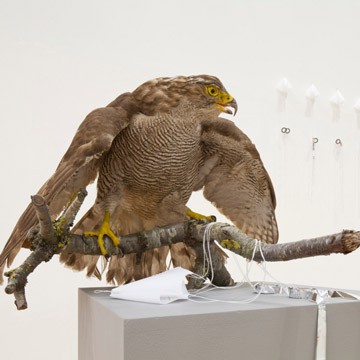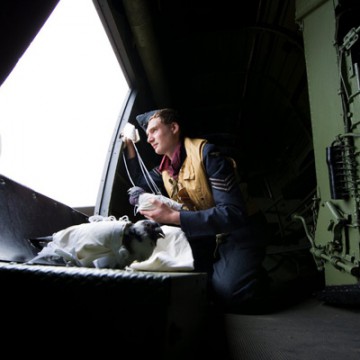
Covariance
‘… Covariance establishes Phelps’ work as being engaged with current critical and artistic practice from around the world. As research science uncovers ever more detail about the fundamental particles of life, there is a danger that it becomes distant from the wider public. We all need systems to understand the world, and artists of Lyndall Phelps’ power and rigour to provoke us with their vision.’
Extract from Covariance: a collaboration about everything, by Tom Freshwater, Contemporary Art Programme Manager, National Trust
Read the full essay here
Softkill
‘Phelps’ new work foregrounds precisely this duality in the nature of human invention. Her fictional scenarios have a darker side, hinting at loss, vulnerability and our manipulation of the natural world. The furred and feathered creatures for whom she has designed individual radar countermeasures are of the kind that are regarded with suspicion or hostility, or at best with ambivalence.’
Extract from Moving Targets, by Angela Weight, Independent Curator and Writer:
‘Lyndall Phelps has patently misapplied such technology here, and it is with great amusement that I see the nefarious invading grey squirrel, so loathed by many, being offered a tray of ‘nuts’ to counter the refined biological ‘radar’ of the goshawk, which in turn sits wearing its characteristic frown when confronted with another crude countermeasure. There is no shame in anthropomorphising the rodent’s desperation and the bird’s sneering.’
Extract from an essay by Chris Packham, Naturalist and Wildlife Broadcaster:
Read the full essay here
Touch
‘The writer Jeanette Winterson in her introduction to the 2010 Jerwood Contemporary Makers exhibition, The Making Game, suggests that:
“The life of objects is a strange one. A maker creates something like a fossil record. She or he is imprinted in the piece. We know that energy is never lost, only that it changes its form, and it seems to me that the maker shape-shifts her/himself into the object. This is why it remains a living thing.”
This energy and process of transformation is apparent in Phelps’ approach to Touch and other projects. She is fascinated by systems, codes, repetitions and what she refers to as ‘extreme processes’, where the mundane is transformed into the extraordinary.’
Extract from Touch by Frances Lord, Curator and Consultant
Read the full essay here
Evacuate
‘Using an object or specific site as a launch pad, Lyndall Phelps’ projects unfold through a meticulous and meandering process of research into the context surrounding them. The associations she weaves are highly subjective yet arrived at through a logical chain of connections opened up along the way. Phelps is often drawn to the obscure and overlooked, areas of science, horticulture or handicraft that demand specialist knowledge and an obsessive eye. Merging myth and anecdote with historical and factual events, Phelps distils her invisible web of relationships into exquisitely refined objects, or archives of detailed information. These objects act as talisman; a contraction of time, space and history into a single tangible entity.’
Extract from The Secret Life of Objects by Lizzie Carey-Thomas, Curator, Contemporary British Art, Tate Britain
Read the full essay here
The Pigeon Archive
‘With one foot in the past and the other firmly in the contemporary, Phelps’ art crosses historical and cultural episodes of human endeavour. The Pigeon Archive brings together a series of works that bear witness to Phelps’ forensic research into the common use of homing pigeons during the First and Second World Wars. Typically, Phelps’ examination of historical moments elicits the most poignant and endearing of human stories. She aligns subjective memory with historical fact to present histories and recollections that offer alternative viewpoints to conventional and official histories.’
Extract from The Pigeon Archive by Michael Stanley, former Director, Modern Art Oxford and Milton Keynes Gallery
Read the full essay here
Knit one purl one
‘Her knitting became a metaphor for multi-layered ideas, certainly the hand-crafted nature of women’s work of this kind, but also the fact that knitting has often been associated with hard labour in Victorian prisons and workhouses. Female inmates were forced to spend the majority of their waking hours making functional objects such as blankets and clothing, or if none were required they were often kept knitting, just for the sake of being given something to do. Phelps needed to fully understand her self-imposed task, and her desire to experience long periods of silence as she tried to work with history.’
Extract from Knit One Purl One by Ann Elliott, Independent Curator
Read the full essay here
Drift
‘When she is hooked by a narrative, Phelps pares it away leaving a simulacrum of the object in her installations. Her practice echoes work by Ann Hamilton and Cornelia Parker, using extreme care to craft her objects, letting the cultural and historical essences seep through by uncanny association, as if from latent memory. By condensing what attracted her to the object – be it a witches’ ball, or a surgical cap – she makes it a fetish, a potent symbol of archetypal fears and dreams.’
Extract from Drift by Cherry Smyth, Curator and Poet
Read the full essay here